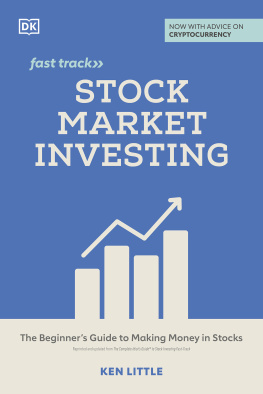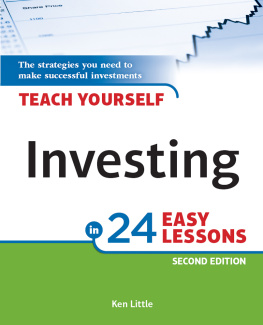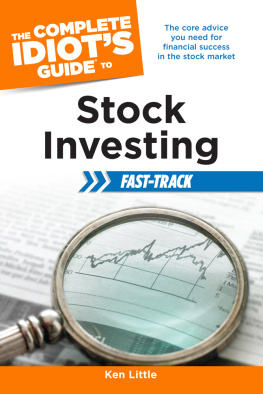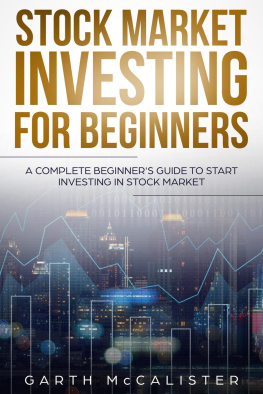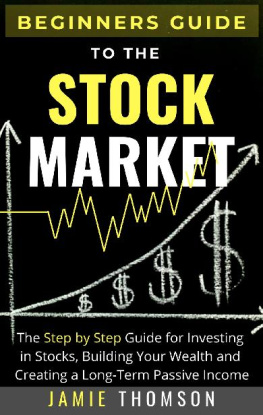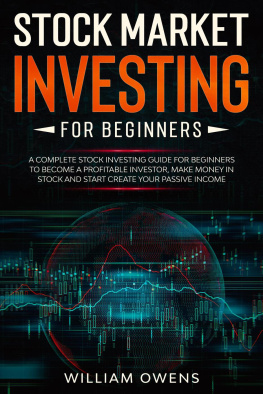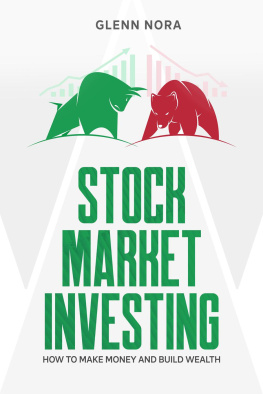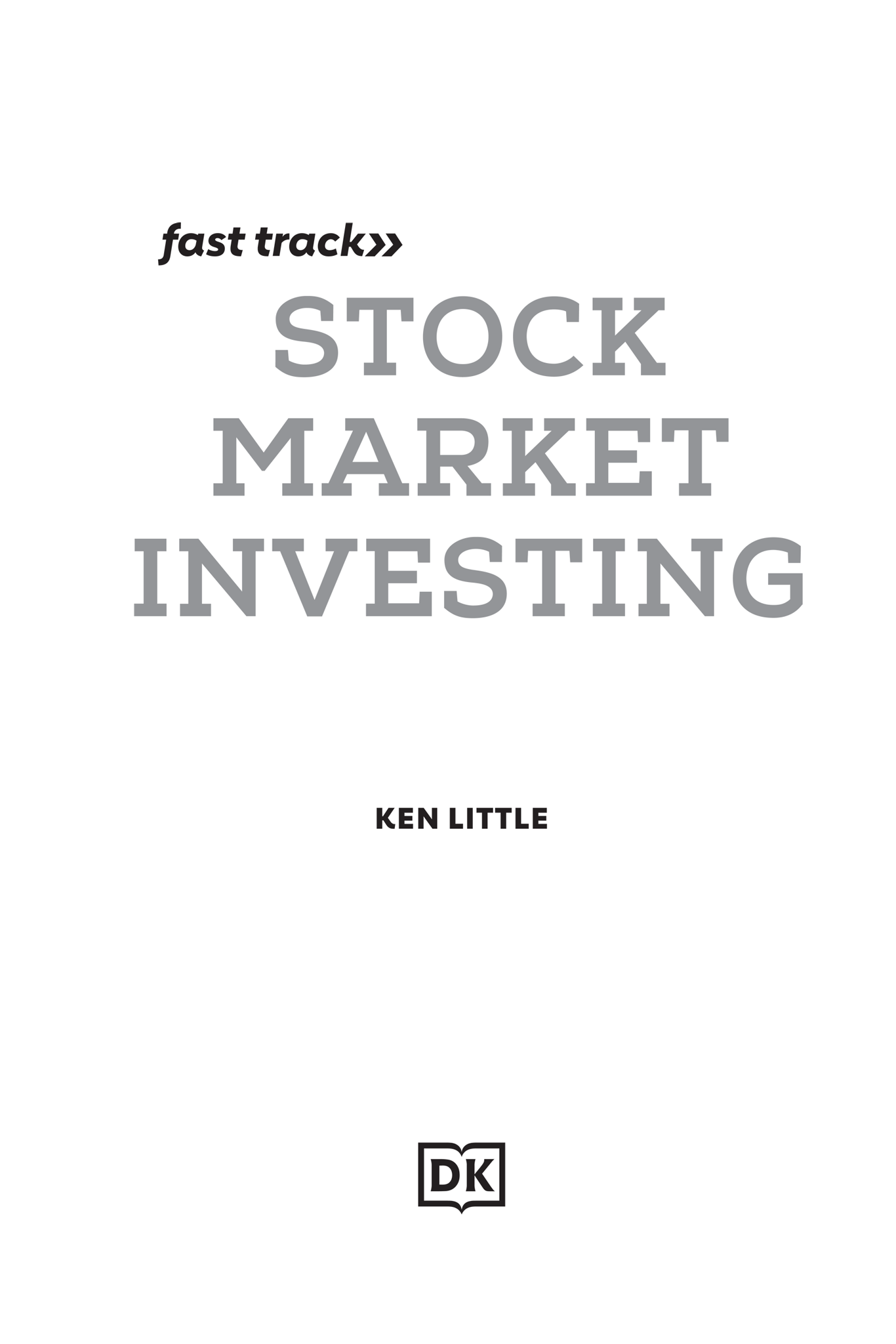CONTENTS
Landmarks
g
How to use this eBook
Preferred application settings
For the best reading experience, the following application settings are recommended:
- Orientation: Portrait
- Color theme: White background
- Scrolling view: [OFF]
- Text alignment: Auto-justification [OFF](if the eBook reader has this feature)
- Auto-hyphenation: [OFF](if the eBook reader has this feature)
- Font style: Publisher default setting [ON] (if the eBook reader has this feature)
- In Settings, change the font size to a size you are most comfortable with.
- Double-tap image to see the details clearly.
Contents
g
To my family, a collection of writers, thinkers, and word nerds for providing their inspiration and love.
g
Introduction
Investing in the stock market can seem like venturing into a foreign country where the inhabitants speak a language you dont understand. People are shouting numbers and terms that are meaningless to you. Screens flash, letters and numbers scroll across endlessly, and it seems to be utter chaos.
Welcome to Wall Street.
The world you see on cable television and buzzing around the internet is only part of the picture. This part of Wall Street is dedicated to stock market traders, and every market move up is cause for celebration, and every move down is cause for alarm.
The other part of Wall Street is quiet, calm, and logical. Its where you find long-term investors who buy great companies at great prices and let them build wealth over time. When you become a resident of this world, you realize that about 98 percent of the daily noise surrounding stocks is meaningless to long-term investors.
This book is for long-term investors and describes how you can identify, analyze, and buy great companies at great prices. Long-term investors buy companies, so most of your work will be valuing companies, not stocks. If analyzing a business seems impossible, not to worry. Thanks to the internet, virtually everything you need to analyze companies is free or available for a small price.
Is it easy to pick great stocks? No, it is not, but it is also not impossibly hard either. It takes work, patience, and an understanding of the process, which is where this book comes in. Ive boiled the process down to its essentials. When you understand the essentials, you are ready to begin. As you work through the process, you will gain confidence and learn more about the benefits of long-term investing.
Warren Buffett became a billionaire many times over by buying great companies at great prices and letting them make him rich over time. Will you make a billion dollars using this books essentials? Probably nothowever, if you do, remember who got you started. I do hope what you learn here helps you build an investment plan to reach your financial goals.
You might want to check out my website, investingforboomers.com, where I write about investing for retirement, especially for the baby boomer generation.
Acknowledgments
Many thanks to the fine folks at Alpha for all their hard work on this book: Brandon Buechley, Rick Kughen and Jan Lynn Neal. It is a much better book than what I submitted, and I am grateful for their suggestions, corrections, and general shepherding of this project.
Trademarks
All terms mentioned in this book that are known to be or are suspected of being trademarks or service marks have been appropriately capitalized. Alpha Books and Penguin Group (USA) Inc. cannot attest to the accuracy of this information. Use of a term in this book should not be regarded as affecting the validity of any trademark or service mark.
g
Chapter 1
The Basics
Investing in stocks can seem complicated and overwhelming. If you believe the hype, you might think that only a select few are capable of successfully investing in stocks. This is wrong thinking. Investing in stocks is not something you do without some preparation and some homework, but if youre willing to put in some effort, it can be a rewarding way to meet your financial goals. Indeed, owning stocks in some form may be the only way to meet your goals.
Lets begin with a brief overview of stocks and why you should consider using them to meet your financial goals. If you are familiar with stocks already, please dont skip this chapter; you may find that some of the things you believe about stocks are wrong. This chapter also serves to help you focus on whats really important.
What Is a Stock?
Common stocks , also known as equities, represent a unit of ownership in a publicly traded corporation. Each share of stock comes with certain rights, such as a vote at the annual meeting on important corporation matters. Because you are an owner of the corporation, it is important that you pay attention to the financial and market news concerning the company you own.
This book focuses on investing in individual stocks as one part of a complete investment program. Your investment program should consist of stocks, bonds, and cash. This focus on stocks will allow you the tools to identify great companies. But you can also own stocks through investment vehicles other than individual ownership. The most common ways are through mutual funds and exchange-traded funds. Many of you likely own both individual stocks and stocks through mutual funds or exchange-traded funds.
Although owning stocks through mutual funds and exchange-traded funds has some advantages, it is usually more expensive than buying individual stocks. However, many investors use several investment types to meet their goals.
Prices in Stock Markets
The stock market, or markets , as they are collectively known, price stocks continuously. These mostly electronic markets match buyers and sellers, theoretically creating an efficient process that prices equities correctly. Stock prices are determined by the daily market forces of supply and demand. However, a stocks price is strongly correlated to its value as an ongoing business. Even though other factors such as economic news may affect stock prices daily, the price will generally reflect how the market values the company.
Companies that show superior economic performance command the highest stock prices over the long term. However, the stock market is not always right. Clever investors spot undervalued (underpriced) companies and take advantage of the opportunity to buy with the hope that at some point, the markets will correctly value the stock, and the investor will profit.
Rights of Ownership
Common stock carries some rights and privileges that are important to individual investors. For example, you have a right to vote at the annual meeting either in person, by mail, or electronically. Also, you have a right to bring issues before the annual meeting that concern you about the company or company policies. In truth, only large investors (usually mutual funds, insurance companies, pension funds, and others that own millions of shares) are really listened to at annual meetings, although by law, every stockholder has certain undeniable rights to bring issues before the meeting. However, if you own stock in a company with an annual meeting nearby, I encourage you to attend just to see how they are run. However, getting into the meeting is usually not as simple as showing up, so investigate what type of credentials you will need. The company will send you a notification of the meeting called a proxy statement. This document reveals the important votes at the annual meeting. It also allows you to assign your vote to a proxy who will vote in your place. The requirements to attend vary depending on where the company is incorporated. If you want to attend in person, the proxy statement will detail the requirements. The proxy statement also contains important information and is worth reading.

